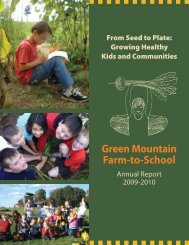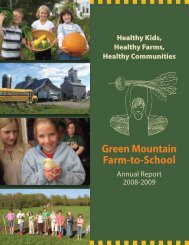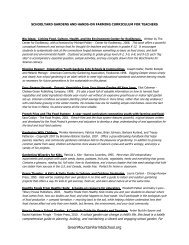A Guide to Starting a Composting Program in Your School - Green ...
A Guide to Starting a Composting Program in Your School - Green ...
A Guide to Starting a Composting Program in Your School - Green ...
You also want an ePaper? Increase the reach of your titles
YUMPU automatically turns print PDFs into web optimized ePapers that Google loves.
7. Follow the specific recipe designed for your site and layer with the bulk<strong>in</strong>g<br />
material recommended (wood chips, wood shav<strong>in</strong>gs, leaves or hay). Spread with<br />
a pitchfork <strong>to</strong> cover the food completely. This will make it less attractive <strong>to</strong><br />
animals.<br />
8. Adjust your trash pickup schedule accord<strong>in</strong>gly <strong>to</strong> reflect the diversion of food<br />
scraps and recycl<strong>in</strong>g. Be sure <strong>to</strong> moni<strong>to</strong>r cost change <strong>to</strong> keep track of the<br />
monetary value of compost<strong>in</strong>g.<br />
On-Go<strong>in</strong>g Procedures<br />
Lots of decomposition takes place <strong>in</strong> a compost pile. In fact, food wastes and bulk<strong>in</strong>g<br />
materials are reduced as much as two thirds! To get the most out of your compost, you<br />
will need <strong>to</strong>:<br />
Check and Ma<strong>in</strong>ta<strong>in</strong> <strong>Your</strong> B<strong>in</strong><br />
o Any structural problems should be reported <strong>to</strong> a supervis<strong>in</strong>g adult so they<br />
can be fixed right away.<br />
Turn <strong>Your</strong> Pile<br />
o When there is a drop <strong>in</strong> temperature or the pile is overflow<strong>in</strong>g out of the<br />
b<strong>in</strong>, it is time <strong>to</strong> turn your pile. Simply, this means <strong>to</strong> mix it up or <strong>to</strong> move<br />
it from one b<strong>in</strong> <strong>to</strong> another.<br />
o The best way <strong>to</strong> turn your pile is <strong>to</strong> use a garden fork or pick fork <strong>to</strong> move<br />
the materials <strong>in</strong> one b<strong>in</strong> <strong>to</strong> another b<strong>in</strong>. The ―green‖ materials and<br />
―brown‖ materials will be mixed up and this will give compost organisms<br />
the opportunity <strong>to</strong> break down more food scraps.<br />
Test and Cure <strong>Your</strong> Compost<br />
o A successful compost will be dark, crumbly, and sweet-smell<strong>in</strong>g. The<br />
process should take about a year.<br />
o Plac<strong>in</strong>g partially-decomposed compost on plants will burn new shoots due<br />
<strong>to</strong> an unstable nitrogen and salt content. To prevent this, be sure <strong>to</strong><br />
―cure‖ the compost before add<strong>in</strong>g it <strong>to</strong> your garden.<br />
o To beg<strong>in</strong> the cur<strong>in</strong>g process, s<strong>to</strong>p add<strong>in</strong>g food scraps <strong>to</strong> the pile.<br />
Throughout the next several months, turn the pile over once a week or<br />
every other week and keep moist.<br />
<strong>Guide</strong> <strong>to</strong> <strong>School</strong> <strong>Compost<strong>in</strong>g</strong><br />
24








